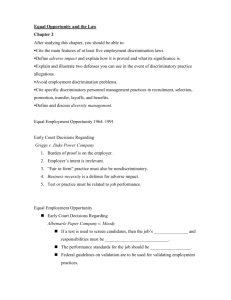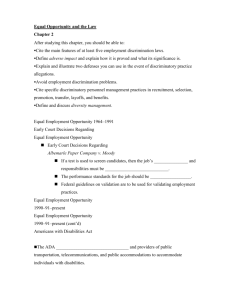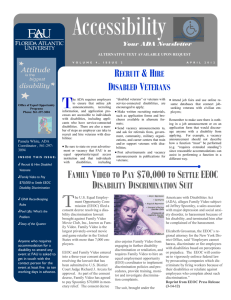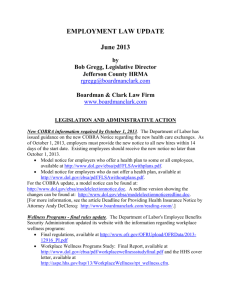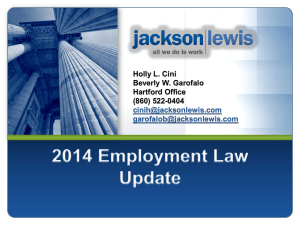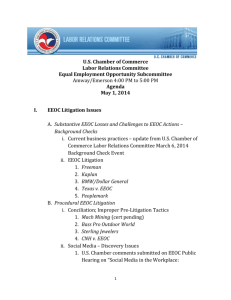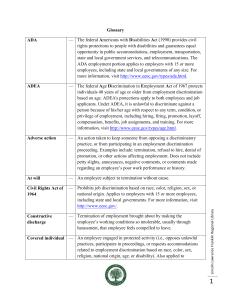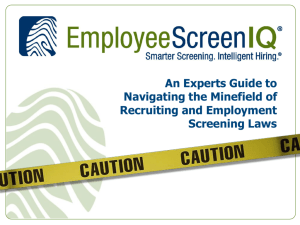Chapter 42 - Employment Discrimination
advertisement
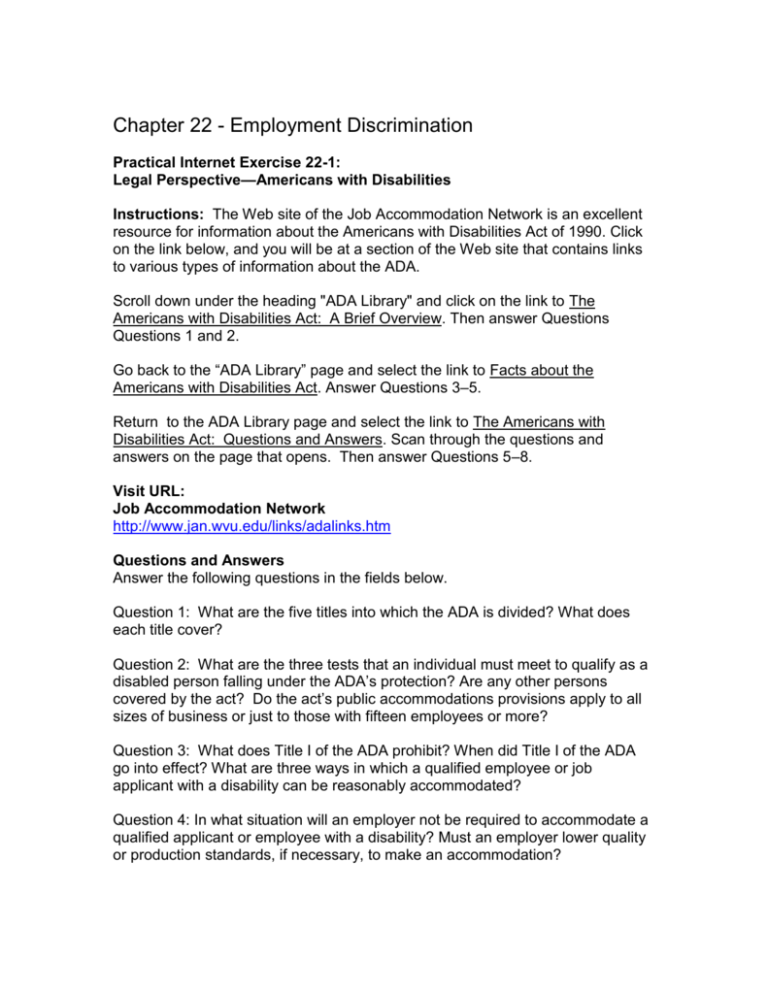
Chapter 22 - Employment Discrimination Practical Internet Exercise 22-1: Legal Perspective—Americans with Disabilities Instructions: The Web site of the Job Accommodation Network is an excellent resource for information about the Americans with Disabilities Act of 1990. Click on the link below, and you will be at a section of the Web site that contains links to various types of information about the ADA. Scroll down under the heading "ADA Library" and click on the link to The Americans with Disabilities Act: A Brief Overview. Then answer Questions Questions 1 and 2. Go back to the “ADA Library” page and select the link to Facts about the Americans with Disabilities Act. Answer Questions 3–5. Return to the ADA Library page and select the link to The Americans with Disabilities Act: Questions and Answers. Scan through the questions and answers on the page that opens. Then answer Questions 5–8. Visit URL: Job Accommodation Network http://www.jan.wvu.edu/links/adalinks.htm Questions and Answers Answer the following questions in the fields below. Question 1: What are the five titles into which the ADA is divided? What does each title cover? Question 2: What are the three tests that an individual must meet to qualify as a disabled person falling under the ADA’s protection? Are any other persons covered by the act? Do the act’s public accommodations provisions apply to all sizes of business or just to those with fifteen employees or more? Question 3: What does Title I of the ADA prohibit? When did Title I of the ADA go into effect? What are three ways in which a qualified employee or job applicant with a disability can be reasonably accommodated? Question 4: In what situation will an employer not be required to accommodate a qualified applicant or employee with a disability? Must an employer lower quality or production standards, if necessary, to make an accommodation? Question 5: What kinds of questions may an employer ask job applicants with respect to disabilities? What kinds of questions may an employer not ask of such applicants? Question 6: Who is protected from employment discrimination under the ADA? Does an employer have to give preference to a qualified applicant with a disability over other applicants? Question 7: Does the ADA require employers to develop written job descriptions? Question 8: Are applicants or employees who are currently illegally using drugs covered by the ADA? Are alcoholics covered by the act? Does the ADA override federal and state health and safety laws? Practical Internet Exercise 22-2: Management Perspective—Equal Employment Opportunity Instructions: The U.S. Equal Employment Opportunity Commission (EEOC) is charged with the mission of ensuring equality of opportunity by enforcing the federal laws prohibiting discrimination in employment. Access the EEOC's Web site below, and then answer Questions 1 and 2. Visit URL: EEOC Web site http://www.eeoc.gov Questions and Answers Answer the following questions in the fields below. Question 1: Under the heading “About EEOC”, select the link to Laws, Regulations, Guidance & MOUs. List several laws that the EEOC is responsible for enforcing. Question 2: Return to the main page of the Web site, scroll down under the heading "Employees & Applicants," and select the link to How to File. Briefly summarize the information on how to file a charge with the EEOC and what information must be included. Practical Internet Exercise 22-3: Social Perspective—Religious and National Origin Discrimination Instructions: In the wake of the terrorist attacks of September 11, 2001, discrimination on the basis of national origin and religion became a harsh reality for many Arabs and others of Middle Eastern origins within the United States. The “racial profiling” of these persons—that is, stopping and searching them at airports or otherwise selecting them for searches and seizures just on the basis of their ethnicity—was widely criticized by civil rights advocates and others. These groups were also subject to a greater degree of discrimination and harassment in the workplace. The below URL will take you to a page on the Web site of the Equal Employment Opportunity Commission (EEOC) that points out how the provisions of Title VII of the Civil Rights Act of 1964 apply to employment discrimination against Middle Eastern groups based on religion, ethnicity, or country of origin. Visit URL: EEOC Facts http://www.eeoc.gov/facts/fs-relig_ethnic.html Questions and Answers Answer the following questions in the fields below. Question 1: Title VII’s prohibitions against workplace discrimination include harassment or any other employment action based on a number of traits or qualities. What are these traits? What examples does the EEOC give of actions that constitute these forms of discrimination? Question 2: What must employers do to avoid liability for harassment based on national origin, ethnicity, or religion? Can employers be held liable for harassment by supervisors and co-workers? What about non-employees under their control—can employers be held liable for harassment by these workers as well? Question 3: What does the EEOC recommend that employers do to prevent harassment on these bases in the workplace? Question 4: Title VII requires employers to reasonably accommodate the religious practices of their employees or prospective employees. Are there any exceptions to this requirement? What are some examples of accommodations that employers may be required to make? Question 5: If an employee believes that he or she has been subjected to discrimination in violation of Title VII, how can the employee file a complaint, or charge, with the EEOC? What is the time period within which an employee must file the charge?
